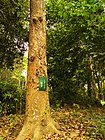Note: This is a project under development. The articles on this wiki are just being initiated and broadly incomplete. You can Help creating new pages.
Shorea robusta - Agnivallabha
Agnivallabha, Sal is an evergreen tree with an elongated crown when young, becoming more rounded as the tree ages. It can grow up to 50 metres tall in fertile soils, but is more likely to be 20 - 25 metres tall in poorer soils. The straight, cylindrical bole can be unbranched for up to 25 metres and up to 200cm in diameter. Sal is a very important multi-purpose tree. It is one of the main commercial timbers of India, being harvested from the wild for local use and export. It also yields a resin that is traded and an oil that is used locally as well as being exported in large quantities. In addition, it supplies tannins, an edible seed and medicines for local use. The leaves are used commercially for making plates and containers
Contents
- 1 Uses
- 2 Parts Used
- 3 Chemical Composition
- 4 Common names
- 5 Properties
- 6 Habit
- 7 Identification
- 8 List of Ayurvedic medicine in which the herb is used
- 9 Where to get the saplings
- 10 Mode of Propagation
- 11 How to plant/cultivate
- 12 Commonly seen growing in areas
- 13 Photo Gallery
- 14 References
- 15 External Links
Uses
Fracture healing, Wound healing, Diarrhea, Ear disorders, Relieves itching [1]
Parts Used
Bark, Sapwood, Heartwood, resin, seeds
Chemical Composition
Common names
| Language | Common name |
|---|---|
| Kannada | ashvakarna, bili-bhogimara, bili-bovu, bilibodige |
| Hindi | sal, ral, shal |
| Malayalam | kungiliyam, mulappumarutu, salavrksam |
| Tamil | venkunkiliyam, tanivirukkam, acuvakarnakam |
| Telugu | jalari-chettu, saala, sarjakamu |
| Marathi | NA |
| Gujarathi | NA |
| Punjabi | NA |
| Kashmiri | NA |
| Sanskrit | agnivallabha, ashvakarna, dhupavrksa, ralasala |
| English | Sal |
Properties
Reference: Dravya - Substance, Rasa - Taste, Guna - Qualities, Veerya - Potency, Vipaka - Post-digesion effect, Karma - Pharmacological activity, Prabhava - Therepeutics.
Dravya
Rasa
Kashaya (Astringent), Madhura (Sweet)
Guna
Rooksha (Dry), Ushna (Hot)
Veerya
Sheeta (Cold)
Vipaka
Katu (Pungent)
Karma
Prabhava
Habit
Identification
Leaf
{{Leaf|Simple|Alternate| shiny, glabrous, about 10-25 cm long and broadly oval atthe base, with the apex tapering into a long point; new leaves reddish, soon becoming delicate green. }[3]
Flower
| Type | Size | Color and composition | Stamen | More information |
|---|---|---|---|---|
| Bisexual | Terminal or axillary racemose panicles | Yellowish white | 25+ | fragrant, yellow or cream white, pedicel subsessile, bracts minute, caducous, calyx 5 lobed, tubular with short valvate lobes, imbricate, ovate-triangular, adnate to the receptacle, outer 3 larger than the inner 2 lobes, about 2-2.5 mm long, petals 5, white, pale yellow to pinkish strips, lanceolate, base slightly connate, apex acuminate, glabrous inside, buff pubescent outside, 10-13 nerved longitudinally. Stamens 25 or more, adnate persistent, short, filaments somewhat flattened or tapering and filiform, anthers subglobose, narrow oblong-ovate, connective subulate, minutely tri-fid towards beyond anther lobes, hair-like. Ovary enclosed inside calyx tube, narrow ovoid, pubescent, tri-locular, 2 ovules per locule, stylopodium distinct or not, style subulate, stigma tri-lobed or tri dentate. |
Fruit
| Type | Size | Mass | Appearance | Seeds | More information |
|---|---|---|---|---|---|
| Winged capsule | 1.5 cm long | ovoid, apex acute, densely pubescent, about 1.5 cm long, enclosed in calyx tube with 3 outer accrescent larger lobes and broader lobes, about 8 x 1.5 cm long and 2 inner ones, smaller, oblong-spathulate, apex obtuse, about 10-12 veined, about 3.5 x 0.5 cm across, calyx lobes base thick, saccate, pubescent. Seeds 1, cotyledons large, fleshy | {{{5}}} | {{{6}}} |
Other features
List of Ayurvedic medicine in which the herb is used
Where to get the saplings
Mode of Propagation
How to plant/cultivate
Season to grow
Soil type
Propagation
Commonly seen growing in areas
Photo Gallery
References
External Links
- Ayurvedic Herbs known to be helpful to treat Fracture healing
- Ayurvedic Herbs known to be helpful to treat Wound healing
- Ayurvedic Herbs known to be helpful to treat Diarrhea
- Ayurvedic Herbs known to be helpful to treat Ear disorders
- Ayurvedic Herbs known to be helpful to treat Relieves itching
- Herbs with Bark used in medicine
- Herbs with Sapwood used in medicine
- Herbs with Heartwood used in medicine
- Herbs with resin used in medicine
- Herbs with seeds used in medicine
- Herbs with common name in Kannada
- Herbs with common name in Hindi
- Herbs with common name in Malayalam
- Herbs with common name in Tamil
- Herbs with common name in Telugu
- Herbs with common name in Sanskrit
- Herbs with common name in English
- Habit - Tree
- Index of Plants which can be propagated by Seeds
- Herbs that are commonly seen in the region of Sub Tropical area
- Herbs
- Tree
- Ayurvedic herbs that don't have flower, fruit and leaf photos
- Ayurvedic herbs that don't have seed photos



